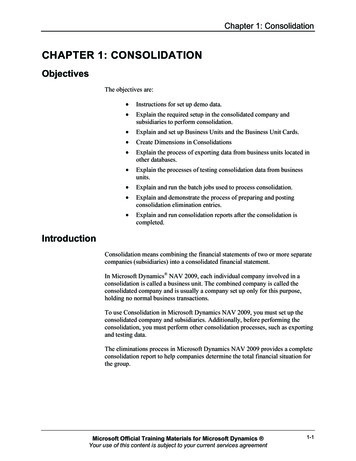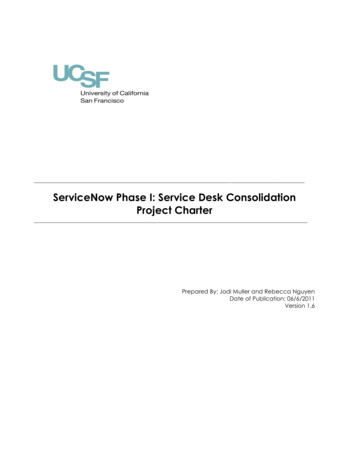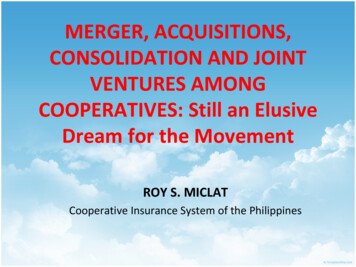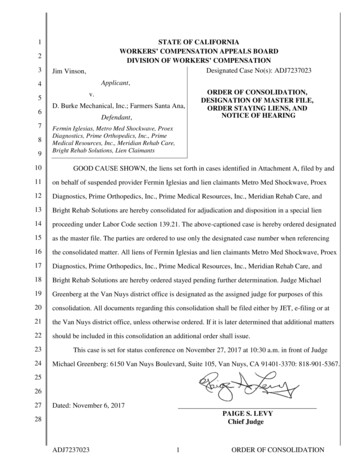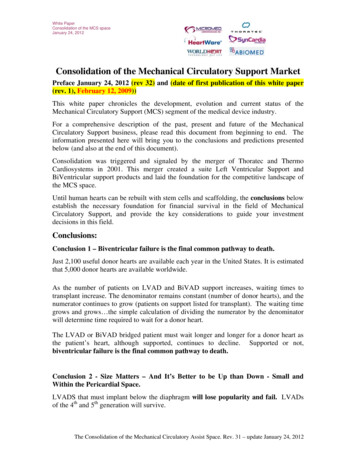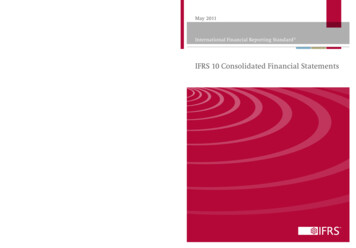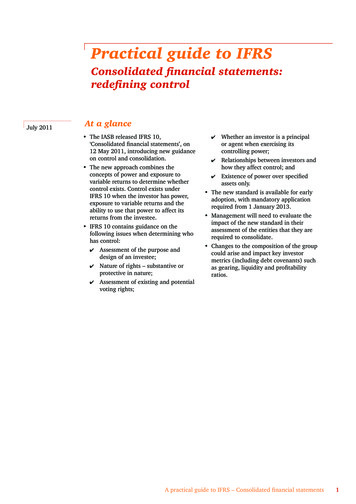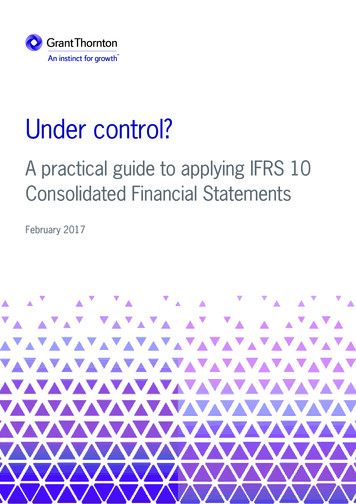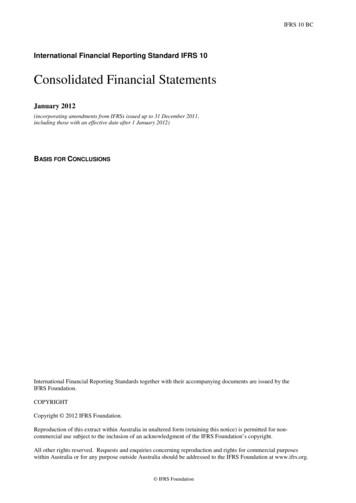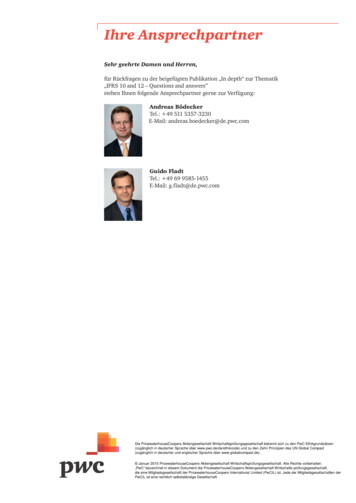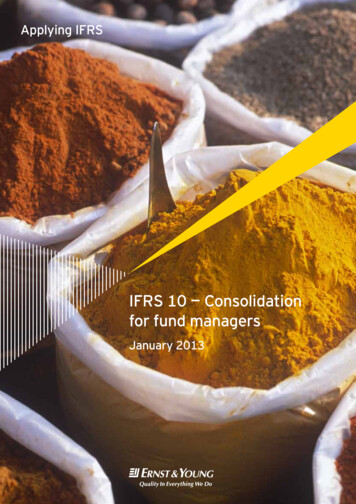
Transcription
Applying IFRSIFRS 10 — Consolidationfor fund managersJanuary 2013
ContentsIntroduction.1What do fund managers need to know?.2A new concept of control.3The link between power and variable returns.5Delegated power — principal or agent.5De facto agents.5Determination of whether the fund manager isacting as principal or agent.61. Scope of decision-making authority.72. Rights held by third parties — removal (or kick-out) rights.73. Remuneration.94. Exposure to variability of returns through other interests.9Decision tree.10Analysis of the examples in IFRS 10.11Methods to calculate exposure to variability.12Continuous assessment.12Investment entity exception to consolidation.13Application examples.15Example 1.15Example 2.16Example 3.18Example 4.19Example 5.21Example 6. 23Business impact.25Appendix A. 29Method 1 — marginal return assuming performancehurdle is met. 29Method 2 — total return. 29
IntroductionIn this publication, we explore the impact of the IASB’snewly applicable standard IFRS 10 Consolidated FinancialStatements (IFRS 10) on fund managers and their funds,and we consider some typical examples that might applyin the industry.Whereas previous standards on consolidation did notspecifically address the unique relationship betweenfund managers and funds, IFRS 10 now contemplatesthose relationships.IFRS 10 — Consolidation for fund managers1
What do fund managers needto know?IFRS 10 establishes a single control model that applies to all entities, replacing guidancepreviously contained in IAS 27 and SIC 12. An investor will control an investee when it has power, exposure to variable returns andthe ability to use such power to affect those returns. An investor has power when it has rights that give it the current ability to direct therelevant activities. This ability to use power to affect returns is evaluated by considering whether the fundmanager is acting as principal or as agent. When a fund manager is deemed to be acting as principal for a fund it manages, thefund manager would consolidate the fund. Conversely, if the fund manager is acting asan agent, it would not consolidate the fund it manages. There are four factors to consider when assessing whether a fund manager is acting asprincipal or agent. Of these factors, a fund manager’s exposure to variability of returnsand rights held by third parties, including the right to remove (or kick out) the fundmanager and the right to direct the relevant activities, will have a critical influence onthe conclusion. Fund managers may reach differing consolidation conclusions over funds they managecompared with their current practice. Understanding the purpose and design of an investee is critical when identifying whohas control by knowing the goal of each investor; that is, why the investor is involvedwith the investee, and what that involvement is. IFRS 10 is applicable for accounting periods beginning on or after 1 January 2013.For entities reporting under IFRS as adopted by the EU, adoption is mandatory onlyfor accounting periods beginning on or after 1 January 2014, but with earlyadoption permitted.2IFRS 10 — Consolidation for fund managers
A new concept of controlIFRS 10 establishes a single control model that applies to allentities, replacing guidance previously contained inIAS 27 Consolidated and Separate Financial Statements (IAS 27)and SIC 12 Consolidation — Special Purpose Entities (SIC 12).IFRS 10’s control model is summarised, as follows:“An investor controls an entity when it is exposed, or has rights to,variable returns from its involvement with the investee and has theability to affect those returns through its power over the investee.”(IFRS 10 paragraph 6)ReturnsDetermine which party, if any,has power; that is, the currentability to direct the relevantactivities. Power arises fromrights, which may include: Voting rightsAssess whether the investor isexposed, or has rights, tovariable returns from itsinvolvement with the investee.Returns can be positive, negativeor both. Examples of returnsinclude: Dividends Potential voting rights(e.g., options or convertibleinstruments) Rights to appoint keypersonnel Decision making rights withina management contract Removal or kick-out rightsPower does not arise fromprotective rights Remuneration Economies of scale, costsavings, scarce products,proprietary knowledge,synergies, or other returnsthat are not available to otherinterest holdersEvaluate linkagePowerAssessing returnsIdentifying powerThe combination of factors is illustrated in the diagram below:LinkageEvaluate whether the investorhas the ability to use its power toaffect the investor’s returns fromits involvement with the investee.If applicable, determine whetherthe investor is a principal or anagent, considering: Scope of its authority Rights held by other parties Remuneration Exposure to variability fromother interestsUnderstand the purpose and design of investeeIFRS 10 — Consolidation for fund managers3
IFRS 10 paragraph B8 states that “An investee may be designedso that voting rights are not the dominant factor in deciding whocontrols the investee, such as when any voting rights relate toadministrative tasks only and the relevant activities are directed bymeans of contractual arrangements. In such cases, an investor’sconsideration of the purpose and design of the investee will alsoinclude consideration of the risks to which the investee was designedto be exposed, the risks it was designed to pass on to the partiesinvolved with the investee and whether the investor is exposed tosome or all of those risks. Consideration of the risks includes notonly the downside risk, but also the potential for upside.”Understanding the purpose and design of the investee helps todetermine a number of important elements in the relationshipbetween fund managers and funds: To which risks was the investee designed to be exposed, andwhat are the risks it was designed to pass on to the partieswith which it is involved? What are the relevant activities? How are decisions about the relevant activities made? Who has the ability to direct the relevant activities? Which parties have exposure to variable returns fromthe investee? How do the relevant activities affect returns? Do the parties that have power and exposure to variable returnshave the ability to use that power to affect returns?Application date and transition provisions IFRS 10 was issued in May 2011 and is effective forannual periods beginning on or after 1 January 2013. InJune 2012, the IASB clarified its transition guidance forfirst-time application of IFRS 10. At the date of initial application (“the beginning of theannual reporting period in which IFRS 10 is applied for thefirst time”), an entity is not required to make retrospectivechanges to its previous accounting for its involvementin entities if the consolidation conclusion reached underIFRS 10 is the same as that reached under the previousguidance in IAS 27 and SIC 12. Relief from retrospective application at the date of initialapplication has been extended for interests disposedof in the comparative period. Furthermore, if, underIFRS 10, there is a change in the consolidation conclusionat the date of initial application, the requirement toadjust comparative information is limited to the periodimmediately preceding the date of initial application.Adjustment to earlier periods is permitted but not required.Within the European Union (EU), adoption of IFRS 10 ismandatory for accounting periods beginning on or after1 January 2014, but, with earlier adoption permitted to allowfor consistent application for EU-registered entities that arepart of a global group.In short, understanding the purpose and design of the investeesheds light on the objective of each investor and therefore whethercontrol exists.4IFRS 10 — Consolidation for fund managers
The link between power and variable returnsTypically, a fund manager is likely to satisfy the first two criteria ofthe control model (described above), as follows: Power — a fund manager is likely to have power (i.e., the currentability to direct the relevant activities). This is because the fundmanager would normally have decision-making rights over therelevant activities. Variable returns — a fund manager is always exposed to variablereturns through its involvement with a fund as a result ofearning management fees and performance fees. In addition,a fund manager often holds a direct interest in the fund (eitherdirectly or potentially through certain related parties).The key determinant in deciding whether a fund manager hascontrol over a fund is the link between power and variable returns.Delegated power — principalor agentAn agent is a party that is engaged to act on behalf of anotherparty (principal), but which does not have control over theinvestee. An investor may delegate decision-making authority toan agent on some specific issues or on all relevant activities, but,ultimately, the investor as principal retains the power. Accordingly,a decision maker that is not an agent is a principal.It is necessary to assess whether the decision maker is acting as aprincipal or an agent, to determine whether the decision maker isdeemed to have control.IFRS 10 provides guidance for analysing control, by asking whetherthe decision maker (e.g., a fund manager), is acting as a principal, oras an agent that is acting primarily on behalf of other investors.An agent cannot have control over the investee and therefore willnot consolidate the investee. In contrast, a fund manager that is aprincipal controls the investee and so will consolidate the investee.De facto agentsWhen assessing control, the nature of relationships with otherparties (such as related parties), will need to be considered inorder to conclude whether these related parties are in effect actingon behalf of the fund manager (i.e., whether they are de factoagents). Where related parties are de facto agents of the fundmanager, the fund manager’s decision-making rights and exposureto variable returns via the de facto agent, together with its own,will need to be considered in totality when assessing control.How we see itConsolidation conclusion and potential implicationsAs a result of applying IFRS 10, fund managers may reach adifferent consolidation conclusion than they do today aboutthe funds they manage, when applying IAS 27 and SIC-12.Different consolidation conclusions will not only be drivenby new guidance under IFRS 10, but also by the level ofjudgement its application requires.For example, in some cases, the fund manager may beregarded as acting as a principal, thus it will consolidateadditional funds and consequently increase the size andcomplexity of its balance sheet. This may have a directimpact on systems, processes and controls, key metricsand ratios, as well as how the fund manager communicateswith investors.If a fund manager were to consolidate additional fundsunder IFRS 10, the fund manager may also have toconsider implications regarding the sufficiency of a fundmanager’s regulatory capital and other regulatory reportingrequirements. In addition, consolidation of additionalfunds may place extra demands on already tight financialreporting timetables.When applying IFRS 10, a fund manager may also concludethat it no longer controls a fund when it had previouslyconsolidated the fund under IAS 27 or SIC-12.Fund managers should perform the new analysis of what, ifany, funds they may need to consolidate to allow sufficienttime for appropriate planning to take place in advance oftheir selected date of application.IFRS 10 — Consolidation for fund managers5
Determination of whether the fund manager isacting as principal or agentIFRS 10 paragraph B60 requires that the following factors areevaluated to determine whether the fund manager is acting asprincipal or agent:1. The scope of the fund manager’s decision-making authorityover the fund.2. The rights held by third parties.3. The remuneration to which the fund manager is entitled inaccordance with the remuneration agreement(s).4. The fund manager’s exposure to variability of returns fromother interests that it holds in the fund.We discuss all four factors in more detail below.Diagram 1 — Evaluating whether a fund manager isacting as principal or agent Scope Weigh the6factorsof decisionmakingautho
4 IFRS 10 — Consolidation for fund managers IFRS 10 paragraph B8 states that “An investee may be designed so that voting rights are not the dominant factor in deciding who controls the investee, such as when any voting rights relate to administrative tasks only and the relevant activities are directed by means of contractual arrangements. In such cases, an investor’s

